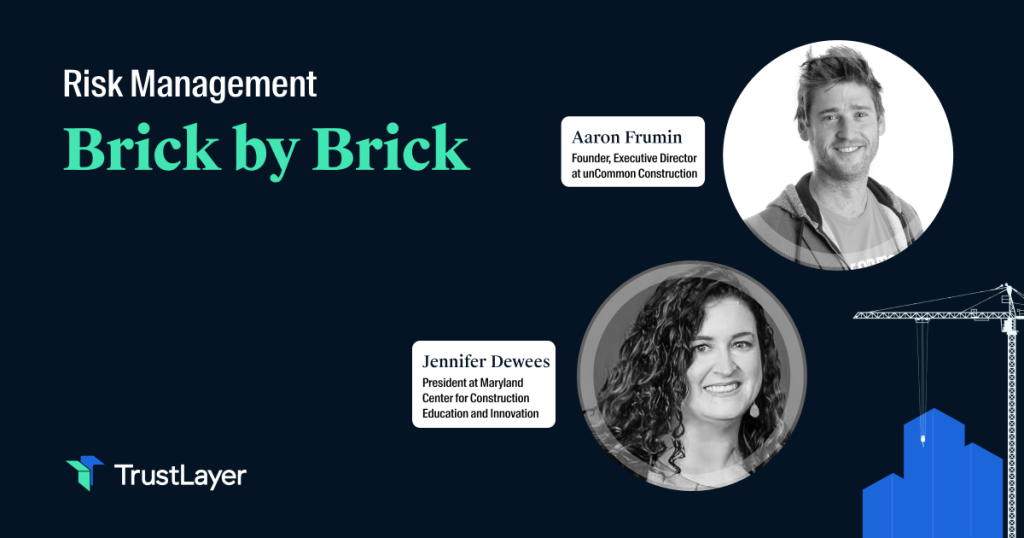Building a Better Future: Empowering Youth in Construction with Aaron Frumin and Jennifer Dewees

On the latest episode of Risk Management: Brick by Brick, Jason Reichl heads to Procore Groundbreak 2023 in Chicago to chat to Aaron Frumin, the Founder and Executive Director of unCommon Construction, and Jennifer Dewees, the president of the Maryland Center for Construction Education and Innovation (MCCEI).
In this episode, Jason, Aaron, and Jennifer discuss the importance of empowering youth in the construction industry. They highlighted the need for increased awareness and exposure to the industry, as well as the role of apprenticeships in providing valuable training and career opportunities. They also addressed the challenges and misconceptions surrounding diversity in construction and the steps that need to be taken to create a more inclusive and diverse workforce.
This is the second in a series of episodes that were recorded at Procore Groundbreak 2023 in Chicago, Illinois. Stay tuned for more!
The Power of Apprenticeships
The apprenticeship model, a once foundational approach to skill-building, has unfortunately faded, depriving youth of practical and valuable experiences. Apprenticeships play a crucial role in bridging the skills gap in the construction industry; they provide young people with hands-on training and mentorship, allowing them to develop the technical and soft skills necessary for success in the field.
unCommon Construction seeks to address this by providing authentic, paid work-based learning experiences where youth can construct houses from start to finish. More than just hands-on work, this approach emphasizes the development of soft skills like problem-solving and initiative. The ultimate goal is for the youth to recognize the diverse range of career opportunities available in construction and to grasp the profound impact that the industry has on society.
As Aaron states, “We need more opportunities for young people to get out into the world and be able to get out in the world in a way that has a practical application for their skills, but also shows them the value of their contributions.”
He goes on to say “We talk a lot in education circles about the achievement gap, and we talk a lot in workforce circles and in our industry about the skills gap. What doesn’t always get as much air time is what we call the belief gap, and this is the gap between what young people are capable of and what others believe they can achieve… So there’s a transformational perspective mindset shift around what young people are capable of, which they then internalize to inform what they believe about themselves right from and about the industry and the value that young people can bring to the industry and the value that the industry can offer to those young people. And this transformational mindset shift like exists in an hour on a job site”.
Overcoming the Challenges: Apprenticeships and Education
One of the most effective ways to attract and train a diverse workforce is through apprenticeship programs. In the interview, Jennifer highlights the success of apprenticeships in the construction industry, which already has the highest number of apprentices compared to any other sector. She believes that apprenticeships can be a game-changer for young people, providing them with hands-on experience and a pathway to a rewarding career.
She recently received a $3 million grant to scale up apprenticeship programs in Maryland. She emphasizes that apprenticeships are not limited to blue-collar jobs and can encompass a wide range of roles, from technical positions to project management. By partnering with schools and industry leaders, she aims to create an infrastructure that supports and expands apprenticeship opportunities.
However, Jennifer acknowledges that there are concerns about safety and legal issues when hiring apprentices, especially those under the age of 18. She reassures risk managers that there are protocols in place, such as the OSHA Student Learner Agreement, which ensures that apprentices are supervised and mentored in a 1-to-1 environment. By dispelling these misconceptions, the industry can open up more opportunities for young talent.
The Image Problem: Breaking Stereotypes and Educating the Masses
One of the main reasons for the lack of diversity in the construction industry is the negative image associated with it. Jennifer Dewees attributes this discrepancy to a dual-fold problem: stereotype-driven misconceptions and the genuine lack of diversity in the sector.
She points out that many people’s perceptions are shaped by limited interactions, such as seeing roadworks or calling a plumber. This narrow viewpoint fails to recognize the vast range of opportunities in the sector, from labor roles to positions in IT, marketing, and more within large commercial construction firms.
While stereotypes play a role in misrepresenting the industry, there’s also a genuine diversity deficit. The construction field is known for being challenging, which might deter potential entrants. For a more inclusive future, Jennifer emphasizes the need for industry transformation, from expanding educational outreach to reimagining its work culture, especially if it aims to attract Gen Z, women, and other underrepresented demographics.
“But then the other part of our image is reality. We are not a diverse industry,” she says. “We are an industry that prides itself on being hard to work in. It doesn’t have to be hard to work in. So I think there is an onus on us as an industry to realizing that we need to change if we really want to capture Gen Z if we want to capture women and other underrepresented populations, because there’s no reason why we still need to be doing business the way we’ve been doing it for, like two millennia”.
She further highlights the need for industry professionals to actively engage with schools and career fairs and encourages companies to go beyond the traditional booth and instead bring interactive exhibits that showcase the cutting-edge technology and innovation in the industry. By making construction more accessible and appealing, the industry can attract a wider range of talent.

